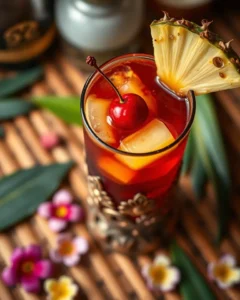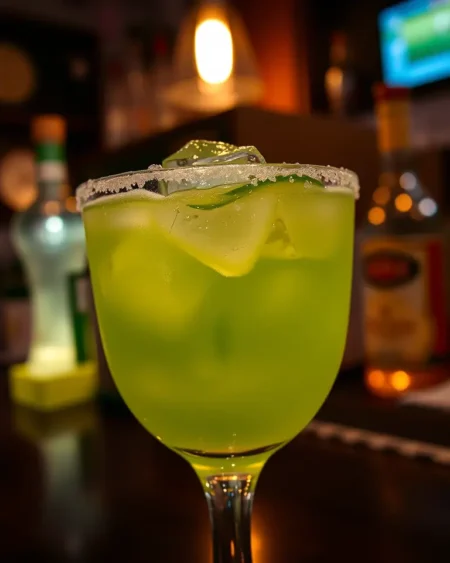The Left Bank Martini offers a sophisticated and refreshing take on the traditional dry martini. This elegant cocktail incorporates the floral notes of elderflower liqueur and the subtle fruitiness of white wine, creating a complex yet balanced flavor profile. Unlike the classic martini, which relies heavily on the interplay of gin and dry vermouth, the Left Bank Martini introduces additional layers of flavor that evoke the chic ambiance of its namesake Parisian district.
The Origins of the Left Bank Martini
The Left Bank Martini was created in 2006 by Simon Difford at the Cabinet Room in London. It was originally crafted to celebrate the launch of St-Germain elderflower liqueur. The name “Left Bank” refers to Saint-Germain-des-Prés, a district on the left bank of the River Seine in Paris, known for its artistic and literary history. This connection to Paris lends the cocktail a sense of sophistication and cultural flair.
Initially, the recipe used Sauvignon Blanc, but it was later found that Chardonnay also worked well. Difford also adjusted the amount of elderflower liqueur and vermouth over time, refining the recipe to achieve the perfect balance.
Ingredients for a Left Bank Martini
The key to a great Left Bank Martini lies in using quality ingredients. Here’s what you’ll need:
- Gin: 60ml (2 oz) – A good quality London Dry gin works best, providing a solid base with its juniper notes. Some recommend gins with citrus or floral notes to complement the other ingredients. Ford’s Gin, Beefeater, Sipsmith, or Bombay are all good options.
- Elderflower Liqueur: 15ml (0.5 oz) – St-Germain is the most common choice. Its sweet, floral notes are essential to the character of the cocktail. Some recipes use elderflower cordial or syrup instead, but the liqueur offers a richer flavor profile.
- Dry White Wine: 15ml (0.5 oz) – Chardonnay is recommended, particularly Chablis. Sauvignon Blanc and Pouilly-Fuissé can also be used effectively. The wine adds a layer of fruitiness and body to the drink.
- Dry Vermouth: 7.5ml (0.25 oz) – A quality dry vermouth such as Dolin or Cocchi is ideal. The vermouth adds dryness and herbal complexity.
Variations
While the above ingredients form the base for a traditional Left Bank Martini, various adaptations exist:
- Wine Substitutions: If you don’t have Chardonnay, a dry white wine like Sauvignon Blanc or even Lillet Blanc can work as a substitute.
- Elderflower Alternatives: Some recipes use elderflower cordial or syrup instead of liqueur, which can reduce the alcohol content while still providing the desired floral notes.
- Vermouth Adjustments: Some prefer a slightly more pronounced vermouth flavor and might increase the quantity slightly.
- Adding Absinthe: A couple of drops of absinthe can add an extra layer of complexity.
How to Make a Left Bank Martini
Here’s a step-by-step guide to crafting the perfect Left Bank Martini:
- Chill Your Glass: Place a martini glass or coupe in the freezer to chill. This helps keep the cocktail cold.
- Combine Ingredients: Fill a cocktail shaker with ice. Add the gin, elderflower liqueur, white wine, and dry vermouth to the shaker.
- Shake Well: Close the shaker tightly and shake well until the outside of the shaker feels very cold, approximately 20-25 seconds. Though some prefer to stir martinis, the Left Bank is often shaken.
- Strain: Remove the chilled glass from the freezer. Strain the cocktail from the shaker into the glass, leaving the ice behind.
- Garnish: Finish with a twist of lime or lemon zest. The citrus oils from the zest will add an aromatic touch. Some recipes omit the zest, letting the floral notes of the drink shine through.
Serving and Enjoying Your Left Bank Martini
The Left Bank Martini should be served immediately after it is made to ensure it is cold and refreshing. The cocktail is best enjoyed in a chilled martini glass or coupe. The elegant presentation and balanced flavors make it suitable for various occasions, whether a casual get-together or a more formal event.
Why It’s a People-First Cocktail
The Left Bank Martini stands out as a people-first cocktail for several reasons:
- Sophisticated Flavor: The combination of gin, elderflower, white wine, and vermouth provides a layered, balanced flavor that is both interesting and approachable.
- Versatile: The cocktail can be tailored to individual preferences by adjusting the ratios of the ingredients. It is easy to modify depending on the available ingredients, as demonstrated by using various white wines, vermouths, and elderflower options.
- Elegant Presentation: The cocktail’s refined look makes it suitable for any occasion. It provides an experience beyond the ordinary.
- Origin Story: The connection to Paris and the story of its creation add a touch of intrigue that makes the experience of drinking it more engaging.
Exploring Gin and Vermouth Options
Choosing the right gin and vermouth can significantly enhance the Left Bank Martini.
Gin Recommendations
- London Dry Gin: A classic London Dry provides a solid base of juniper and spice, allowing the other flavors to stand out without being overpowered.
- Floral or Citrus Gins: Gins with notes of citrus or floral botanicals can complement the elderflower and white wine, creating a harmonious flavor profile. Some brands include Tanqueray No. 10, Sipsmith, or Bombay Sapphire.
- Ford’s Gin: This gin, developed by bartender Simon Ford, is known for its balance and notes of citrus, pine, and spice, making it an excellent option for a Left Bank Martini.
Vermouth Recommendations
- Dry Vermouth: A high-quality dry vermouth, such as Dolin or Cocchi, is crucial for the cocktail. These vermouths have a dry, herbal profile that is essential for balancing the sweetness of the elderflower liqueur. Belsazar Dry Vermouth is another option that adds a peachy note.
The Allure of the Left Bank Martini
The Left Bank Martini is a testament to the evolution of the classic martini. It showcases how the interplay of different spirits, wines, and liqueurs can transform a traditional drink into something new and exciting. Its appeal lies in its balanced flavor, sophisticated presentation, and the fascinating story behind its creation. Whether you’re a seasoned cocktail enthusiast or new to the world of mixology, the Left Bank Martini is worth exploring. It provides a refreshing and elegant experience.







